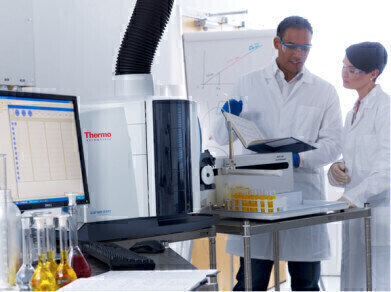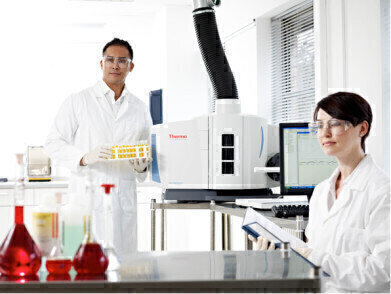-
 Analysis of Trace Elements in Naphtha using the Thermo Scientific iCAP 6500 ICP-OES
Analysis of Trace Elements in Naphtha using the Thermo Scientific iCAP 6500 ICP-OES -
 Simplified analysis of trace elements in gasoline with the Thermo Scientific iCAP 6000 Series ICP-OES
Simplified analysis of trace elements in gasoline with the Thermo Scientific iCAP 6000 Series ICP-OES -
 Analysis of wear metals, contaminants, and additive elements in used lubrication oils according to ASTM D5185
Analysis of wear metals, contaminants, and additive elements in used lubrication oils according to ASTM D5185
Analytical Instrumentation
Leading ICP-OES performance for key petrochemical applications
Jul 20 2011
White papers are available to download describing the use of ICP for the detection of trace element contaminants in naphtha gasoline and lubrication oil samples. These notes demonstrate the performance capabilities, stability and simplicity of the Thermo Scientific iCAP 6000 Series ICP-OES.
The Analysis of Trace Elements in Naphtha using the Thermo Scientific iCAP 6500 ICP-OES
The analysis of trace metals in naphtha is important in the petrochemical industry, especially in the cracking of hydrocarbons. The presence of trace metals can severely hamper this process as well as poisoning the catalysts used, which are often expensive. The Thermo Scientific iCAP 6500 ICP-OES Radial was used for this analysis of trace element in naphtha; the radial instrument option was selected due to the interferences from carbon based emissions which can be reduced by optimizing the radial viewing height. The IsoMist is a Peltier cooled spray chamber accessory which was used in conjunction with a glass concentric nebulizer allowing for analysis to take place with no sample preparation.
Download full application note
Simplified analysis of trace elements in gasoline with the Thermo Scientific iCAP 6000 Series ICP-OES
The analysis of lead in gasoline is a common trace element application. Lead not only affects the performance of an engine by poisoning the catalytic converter but will also be transported to the environment via exhaust emissions. The Thermo Scientific iCAP 6000 Series Radial ICP-OES was used for the analysis of trace elements in gasoline. The radial view instrument was selected as the plasma viewing height can be optimized to minimize interferences from matrix elements such as carbon. The IsoMist temperature controlled spray chamber accessory was also used to reduce the temperature of the spray chamber to -15 degrees C for the analysis and was used in conjunction with a glass concentric nebulizer.
Download full application note
Analysis of wear metals, contaminants, and additive elements in used lubrication oils according to ASTM D5185 using the Thermo Scientific iCAP 6300 ICP- OES
The standard method ASTM D5185 is suitable for the analysis of additive elements, wear metals, contaminants in used lubricating oils and selected elements in re-refined and virgin base oils. A total of 22 elements can be determined by this method and the resultant trace element composition of the sample can be used to monitor the condition of the equipment and define when corrective action is needed. ICP-OES is an ideal technique for this analysis due to its high temperature source which dissociates any organometallic compounds and also has the ability to handle difficult organic solvent matrices. The Thermo Scientific iCAP 6300 ICP-OES was used for this analysis as it employs a high resolution echelle spectrometer with a unique Charge Injection Device (CID) detector that provide excellent spectral resolution to minimize interferences.
Digital Edition
PIN 25.2 Apr/May
April 2024
In this Edition Safety - Carbon monoxide toxic and flammable gas detection Analytical Instrumentation - Density: A fundamental parameter at critical stages within the petroleum sector...
View all digital editions
Events
May 06 2024 Riyadh, Saudi Arabia
May 06 2024 Houston, Tx, USA
May 06 2024 Houston, Tx, USA
Canada Gas & LNG Exhibition & Conference
May 07 2024 Vancouver, BC, Canada
May 08 2024 Lahore, Pakistan

















